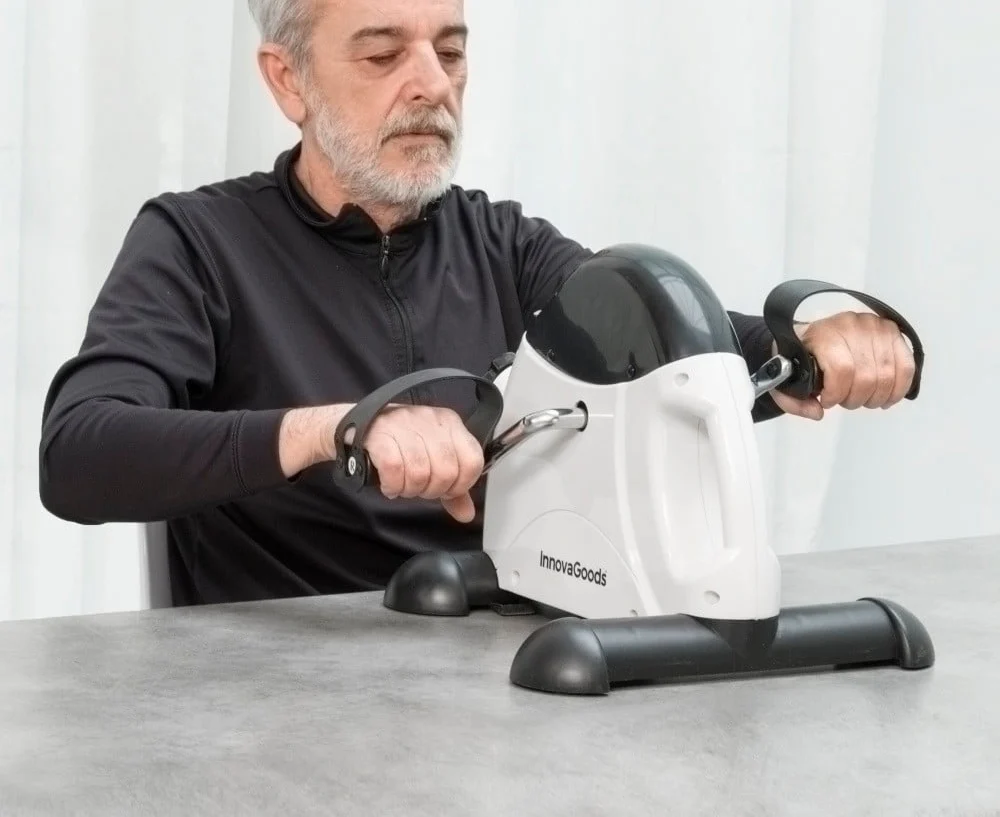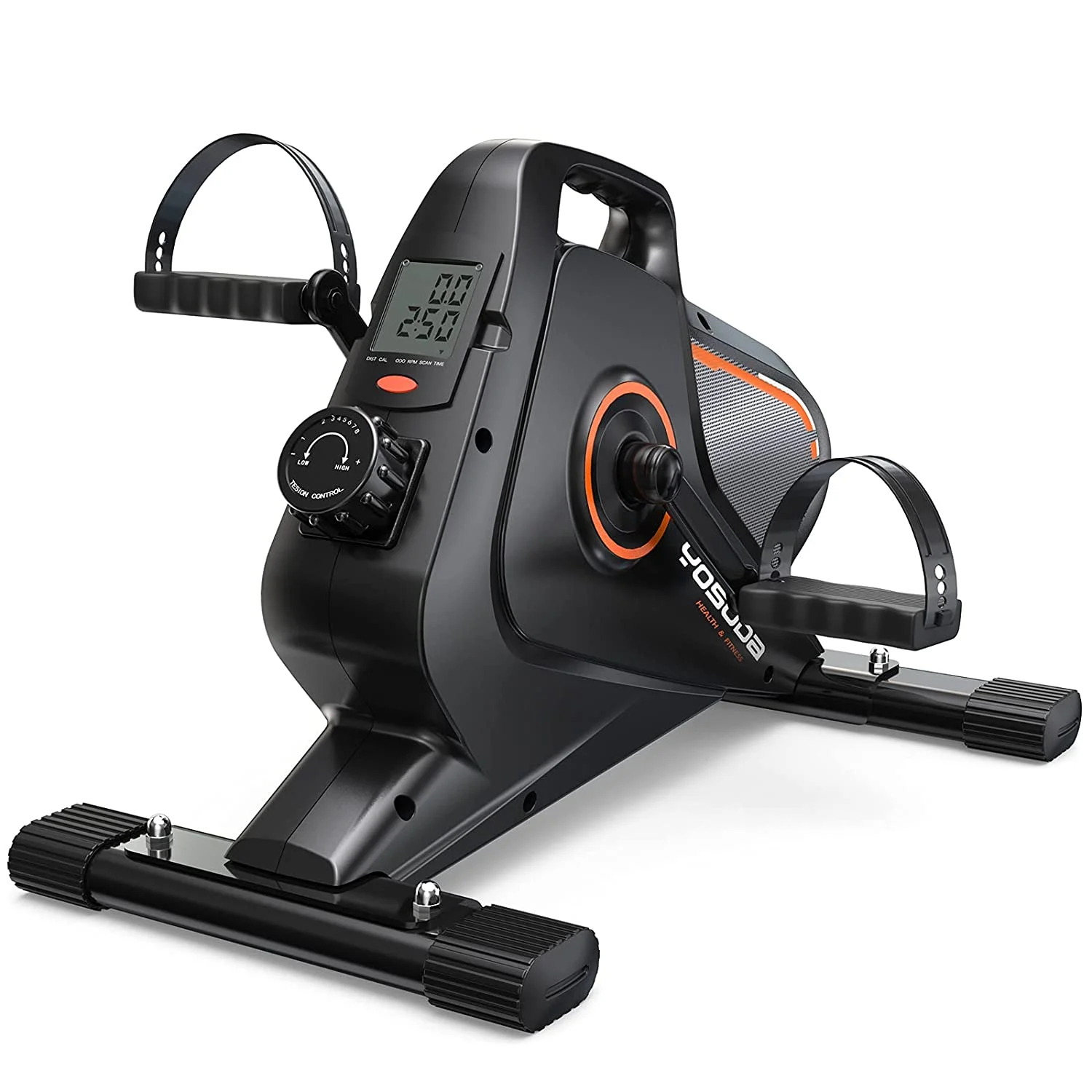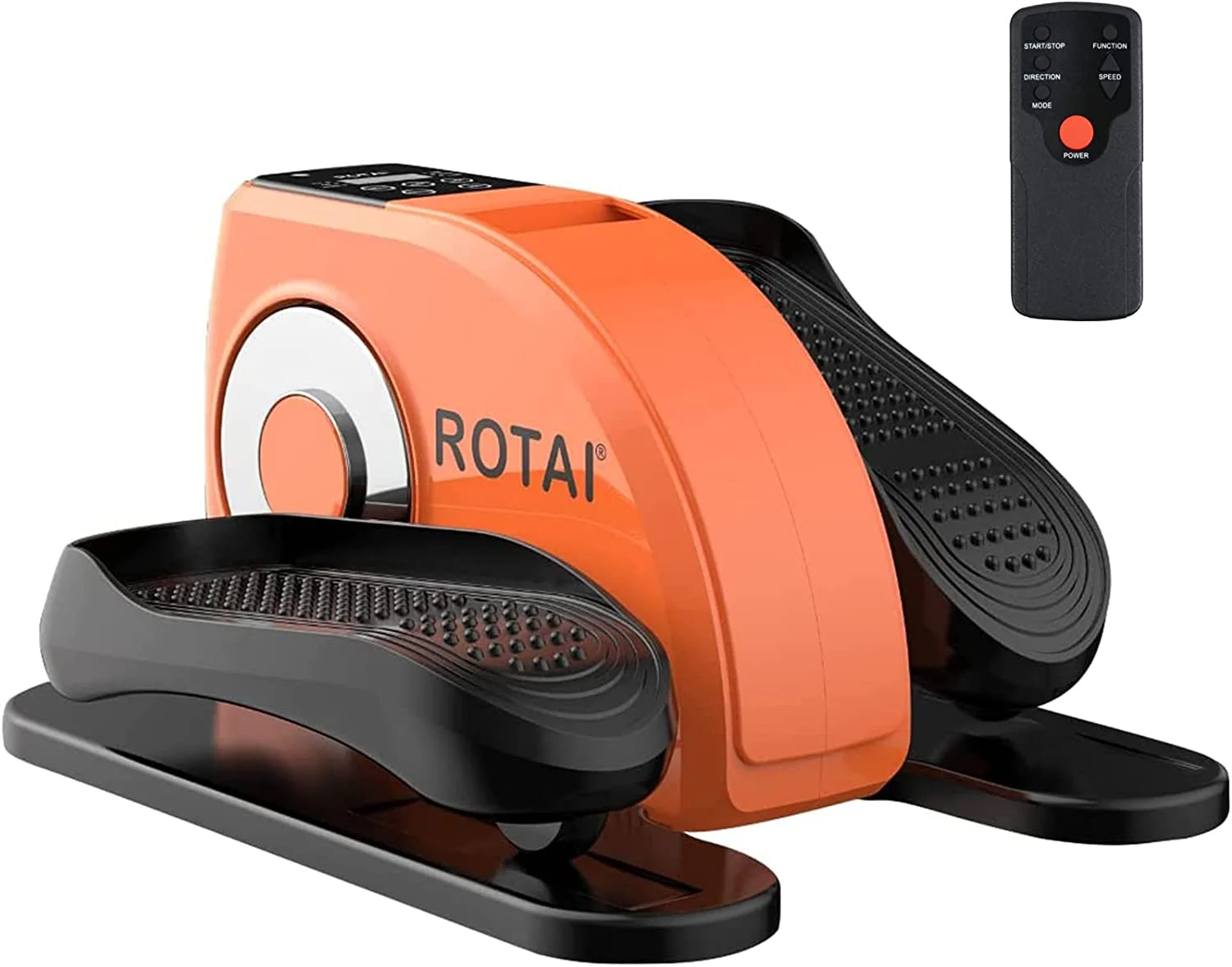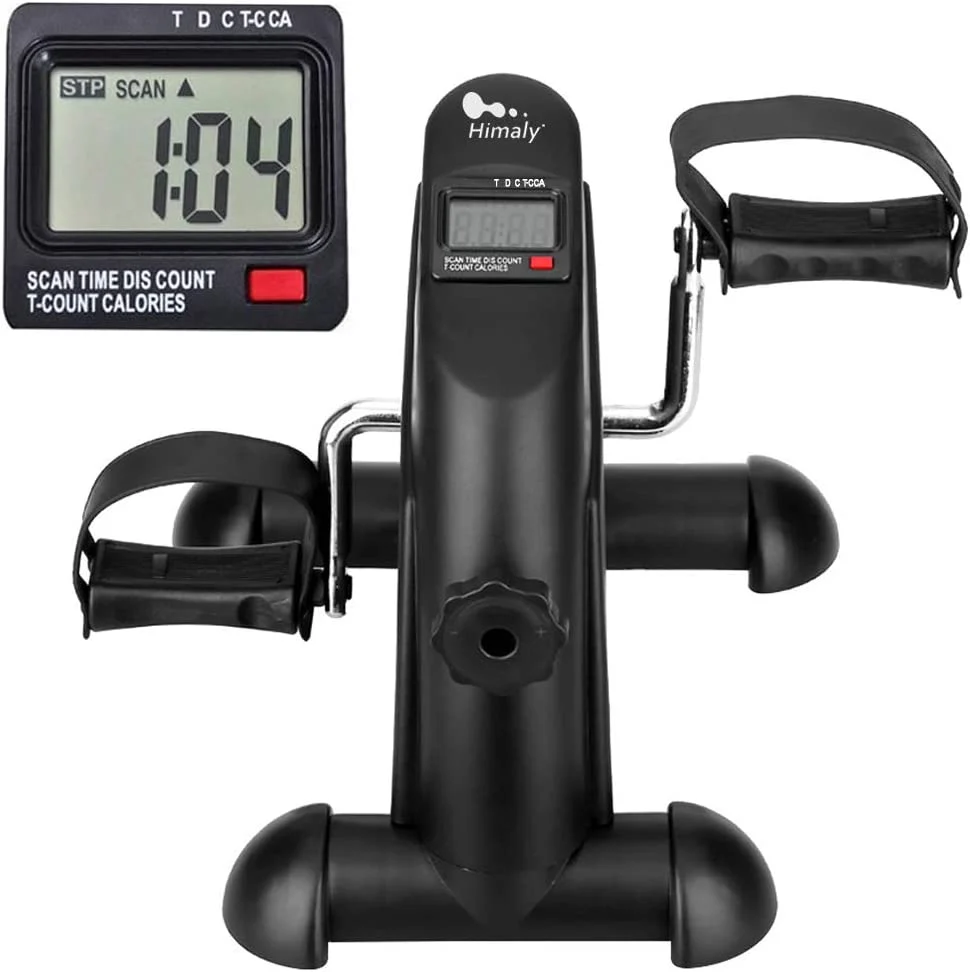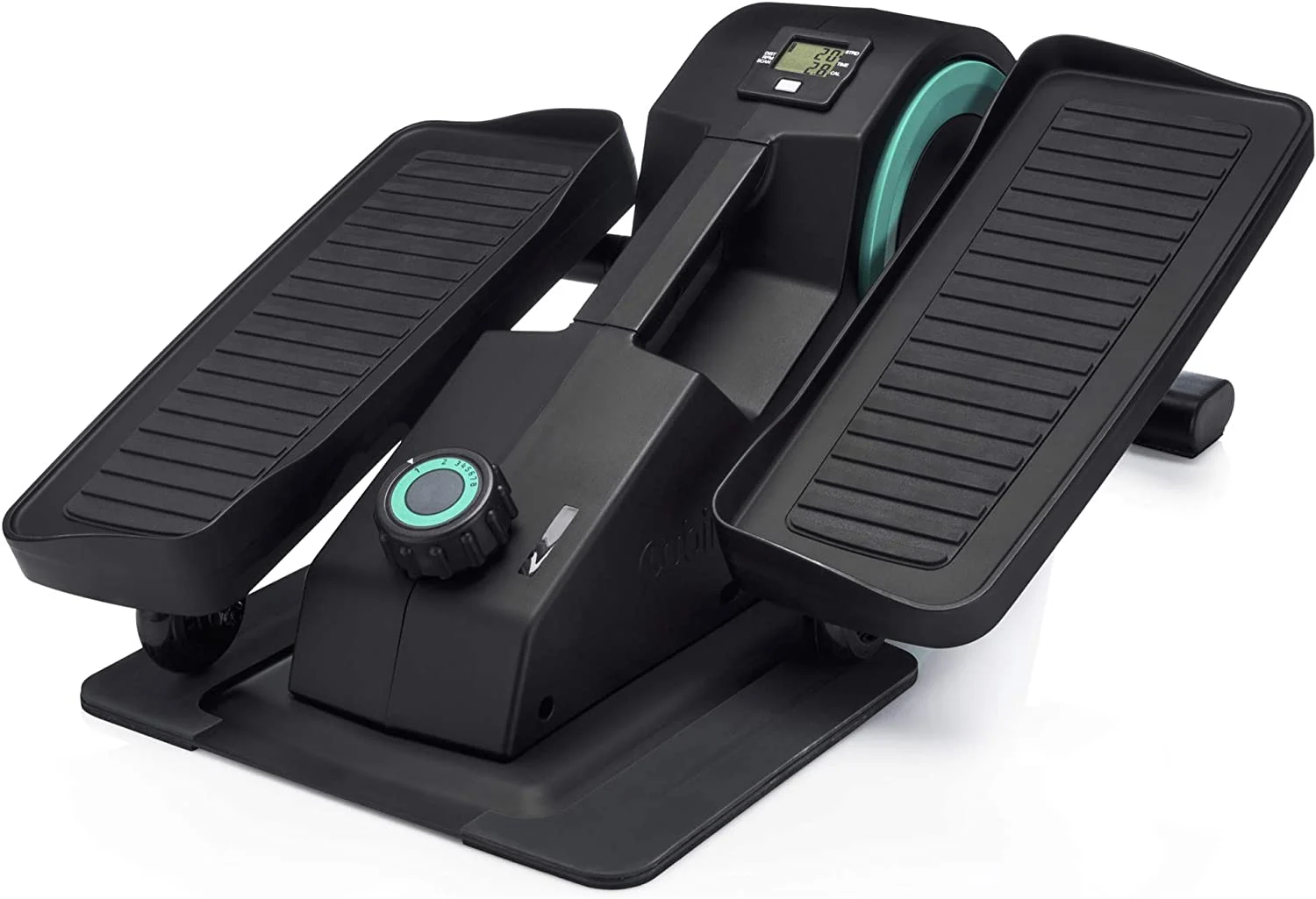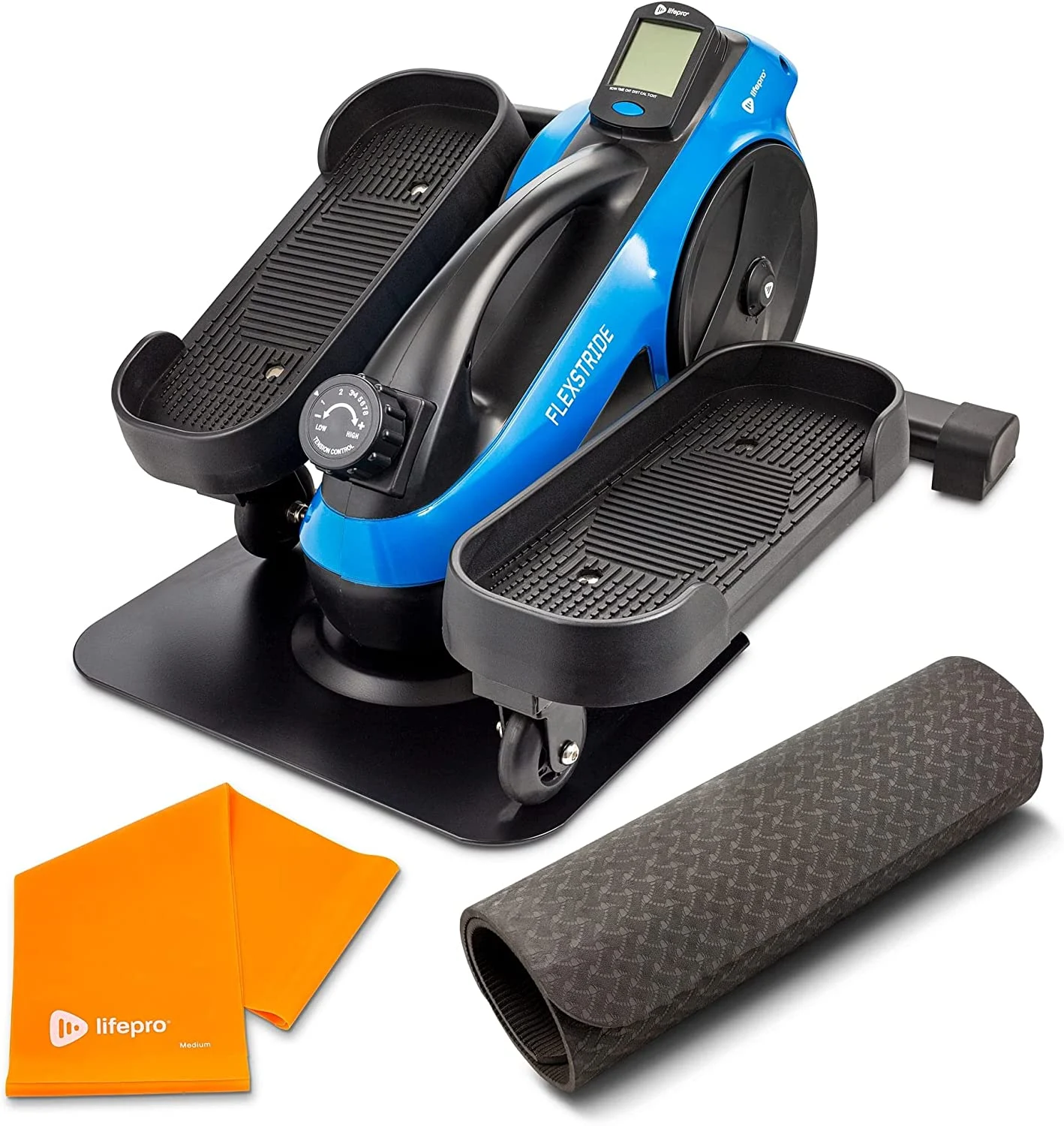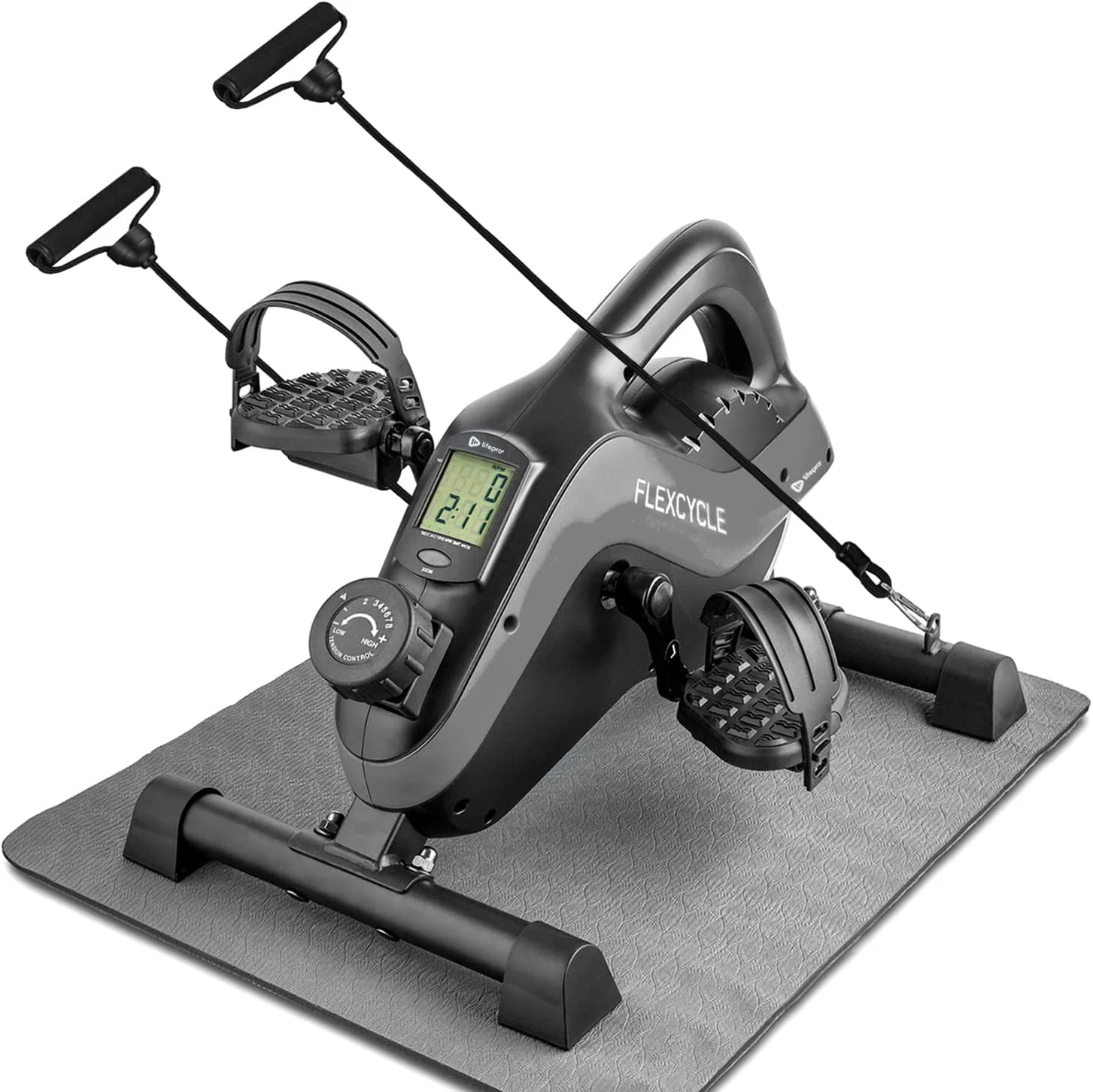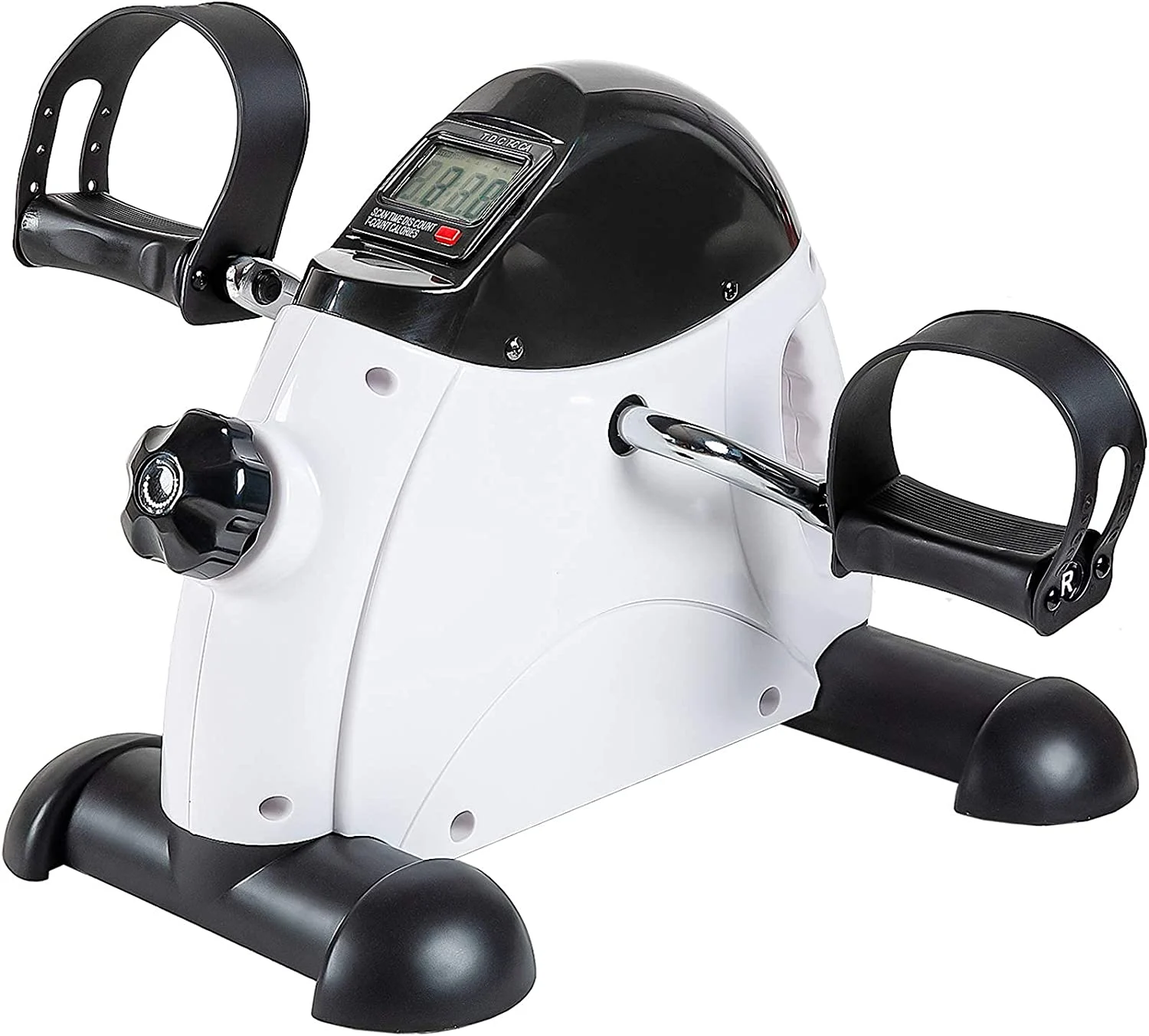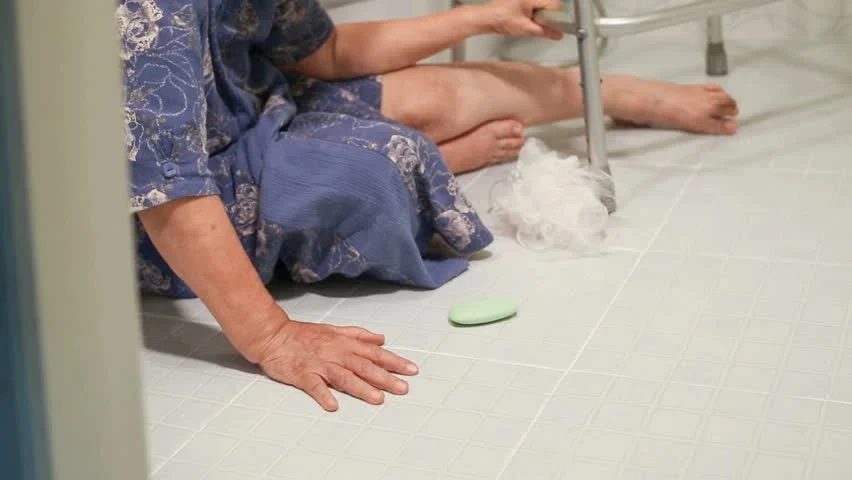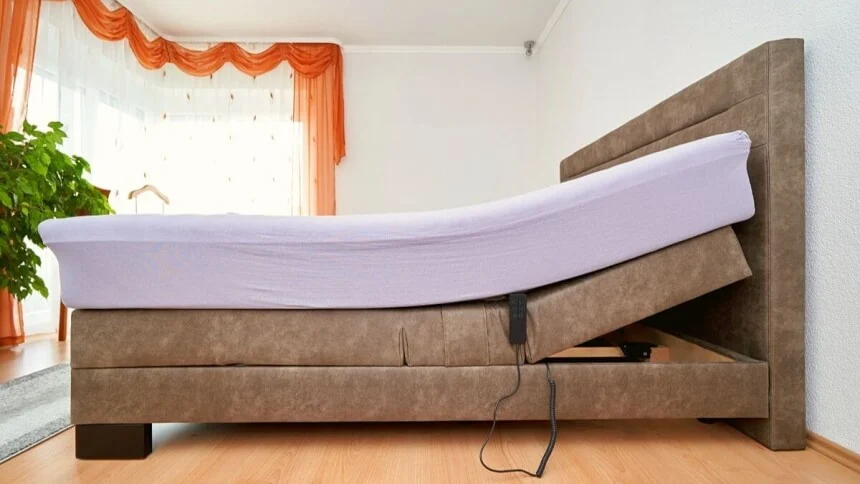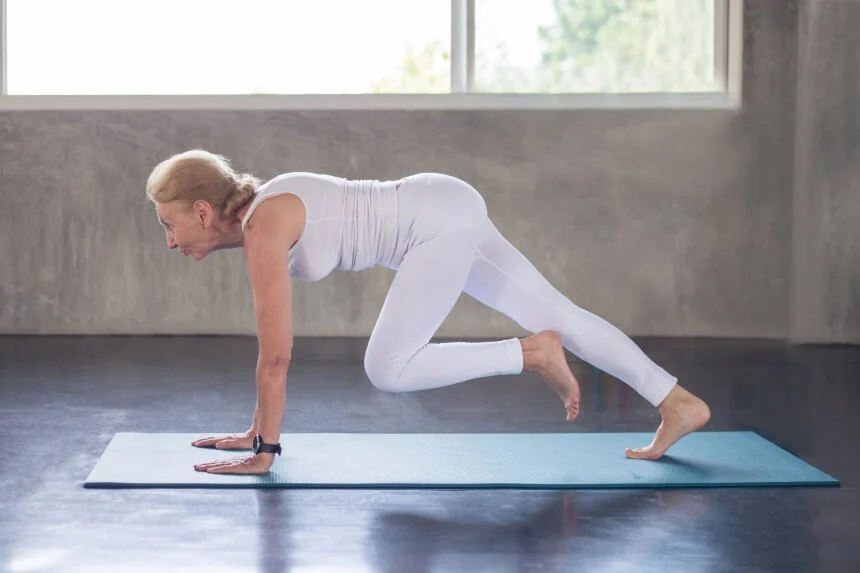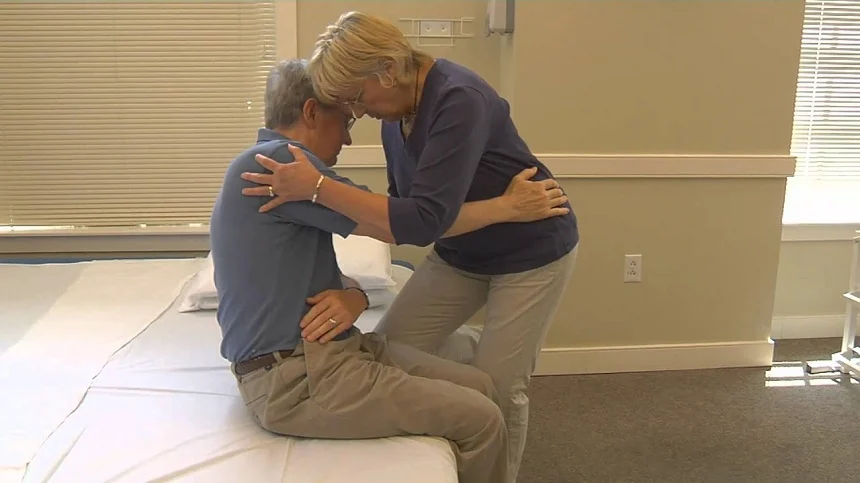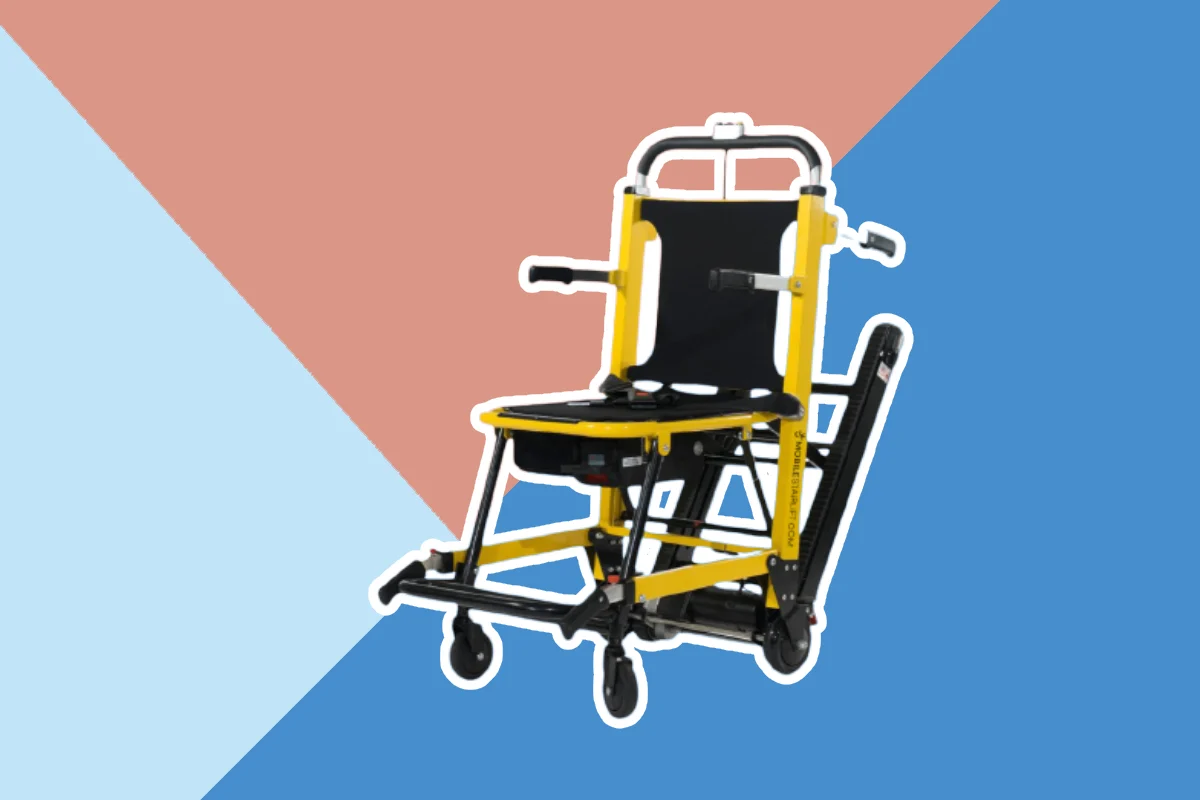Did you know that sitting is often called the new smoking? Too much time spent being sedentary is linked to a multitude of health problems, including obesity, heart disease, and even cancer. Unfortunately, older adults tend to be among the most sedentary – over one-third of adults worldwide aren’t active enough, and people over 60 are the least active group (who.int). That’s why it’s so important for seniors to stay active, and one of the best (and easiest) ways to do that is with a pedal exerciser.
We’ve tested 15 different models (updated for 2025) and chosen the 7 best pedal exercisers for seniors. Our pick for the Editor’s Choice is the YOSUDA Bike Pedal Exerciser. This high-quality, compact, and lightweight pedal exerciser offers 8 levels of resistance, which is important so seniors can adjust the intensity to their fitness level. It also features a large, bright LCD display for tracking workout stats, so older users won’t have to strain to read it. With its stable, floor-hugging design and nearly silent operation (under 20 dB), you can exercise comfortably without disturbing anyone. Overall, the YOSUDA makes it easy for seniors to start and finish a pedal workout independently – it’s an all-around winner for safety, convenience, and performance.
SeniorFitness is reader-supported. We may earn a commission through products purchased using links on this page. Learn more about our process here
TL;DR:
Pedal exercisers are a simple, low-impact way for seniors to stay active from the comfort of a chair or couch. We tested 15 models and picked the YOSUDA Bike Pedal Exerciser as our top choice for its smooth, quiet operation, adjustable resistance, and easy-to-read display. The ROTAI Bike Pedal Exerciser offers premium features like a remote control and motorized options, while the Himaly Mini Exercise Bike delivers great value at a low price. Key features to consider when choosing include resistance levels, stability, portability, and noise level. Whether you want gentle movement to improve circulation or a light cardio workout, these 7 pedal exercisers provide an easy way to boost mobility, health, and independence at home.
Quick Summary
- Editor’s Choice: YOSUDA Bike Pedal Exerciser A quiet, under-desk pedal bike that’s perfect for gentle arm and leg workouts. It features smooth magnetic resistance with 8 levels and a clear LCD monitor. Compact and sturdy, it’s ideal for senior fitness at home
- Premium Pick: ROTAI Bike Pedal Exerciser A top-of-the-line pedal exerciser with both auto (electric) and manual modes. Comes with a handy remote control for no-bend operation. Great for rehabilitation and low-effort workouts with 4 speed settings and an easy-to-read screen.
- Best Value: Himaly Mini Exercise Bike A budget-friendly, lightweight pedal exerciser for legs and arms. It has an LCD display and adjustable tension knob. While simple, it includes non-slip pedals and is extremely portable – a great choice for seniors looking to stay active without breaking the bank.
- Best Pedal Size: Cubii JR1 Bike Pedal Exerciser A sleek under-desk pedal machine with 8 resistance levels. Its low profile means it fits under most desks. Tracks your activity with a built-in display and even syncs to a mobile app for goal-setting. Smooth gliding motion that’s easy on the joints.
- Best Accessories: LifePro Bike Pedal Exerciser This sturdy under-desk bike supports up to 220 lbs and includes extra accessories like a mat, tether strap, and resistance bands for arm workouts. Eight magnetic resistance levels and Bluetooth app integration make it a feature-rich option for dedicated users.
- Best for Arms & Legs Workout: LifePro FlexCycle Exercise Bike A versatile mini exercise bike with 8 resistance levels and a built-in LCD. It comes with attachable resistance bands, so seniors can work out their arms and legs together. Smooth, whisper-quiet operation and even offers a free rehab app for guided workouts..”
- Best Weight Capacity: GOREDI Pedal Exerciser A heavy-duty pedal exerciser built to support up to 400 lbs of user weight. It’s very stable and comes with a wear-resistant, non-slip mat for secure use. Features an easy-read 5-function display and an adjustable tension knob for both light and more robust workouts.
Top 7 Pedal Exercisers for Seniors Review 2025
1. Editors Choice Pedal Exerciser for Seniors
YOSUDA Bike Pedal Exerciser
Features
- Max. Weight Capacity:260 lbs.
- Dimensions:21.3×12.3×14.4 inch.
- Item Weight:22 lbs
- Warranty:1 year
More features: 8 adjustable levels of magnetic tension, 4 anti-slip rubber pads, less than 20dB noise level, multi-functional LCD display, 1-year free parts replacement
YOSUDA Bike Pedal Exercise is our Editor’s Choice thanks to its great performance, safety, and comfort. This compact, portable exercise bike is perfect for seniors or anyone looking for a low-impact workout. Featuring 8 levels of adjustable magnetic tension and 4 anti-slip rubber pads, it’s easy to customize your workout to your specific needs. And with a multi-functional LCD display, you can keep track of your progress as you go. Plus, with a noise level of less than 20dB, you can be sure that your workout won’t disturb the peace. Best of all, the YOSUDA Bike Pedal Exerciser comes with a 1-year free parts replacement warranty, so you can be confident in your purchase.
This pedal exerciser hits all the high notes but there is one really great feature it’s missing, and that’s a remote! Unlike the Premium Pick, this model has no remote control to make convenient adjustments without having to bend or stop to do so. It is easy to adjust but there’s just something about the convenience of a remote that stands out!
What stands out?
- Low-impact stationary bike pedals
- Perfect for arm and leg workouts
- 8 adjustable resistance modes
- Lightweight
- Easy to use and store
- Large LCD display to monitor time, distance, speed, and calories
- Anti-slip pads
- Almost noiseless
What cons did we manage to find?
- Some customers complaint that pedal assembly may be a bit hard
2. Premium Pick Pedal Exerciser for Seniors
ROTAI Bike Pedal Exerciser
Features
- Overall dimensions:19.7 x 17.5 x 11 in
- Weight:15 lbs
- Speeds:4
- Max speed:1.25 mph
- Warranty:2-year limited
More features: bi-directional, remote control, manual controls, auto-workout, digital screen, ABS plastic exterior, shiatsu pedals, skidproof bottom
The ROTAI Bike Pedal Exerciser is another device that impressed during our testing process. In fact, it is the best leg exerciser for traveling elderly. Why’s that? This product has every convenient feature seniors need in a fitness tool. It works in two modes; manual and automatic. For the automatic mode, plug in the device, and it starts working. And you can use an included remote control to operate the machine while you sit and relax. Additionally, this leg exercise equipment for elderly features an LCD that tracks exercise time, speed, calories burned, working pattern, distance, and counter.
Moreover, the ROTAI Bike Pedal Exerciser has more modes than the Cubii JR1 leg exerciser, which offers only an automatic mode. That means you can use the ROTAI exerciser while it’s plugged in and when it’s not. Although this device has only four moving speeds compared to the Cubii exerciser’s eight, it is the cheaper option. Also, the ROTAI exerciser sports silent wheels that work quietly, making them suitable for office and travel, but that’s not the case with the Cubii exerciser’s squeaking wheels. Furthermore, the ROTAI exerciser’s two-year warranty is more generous than the SITFIT Sit Down and Cycle! and Cubii JR1 leg exerciser’s warranty offers.
What stands out?
- Manual and auto workout modes give flexible exercise options
- Remote control offers seamless operation
- LCD shows vital exercise details such as distance, speed, calories burned, etc.
- Shiatsu pedals stimulate feet muscles and aid circulation
- Four defined sponges in the bottom ensure no skidding when used on the plane
What cons did we manage to find?
- It starts in reverse mode, which some users may find annoying
3. Best Value Pedal Exerciser for Seniors
Himaly Mini Exercise Bike
Features
- Max. Weight Capacity:not specified
- Dimensions:16.54×12.6×7.87 inch.
- Item Weight:8.8 lbs.
- Warranty:2 years
More features: LCD display, anti-slip brackets, non-slip pedals, adjustable pedal resistance
Looking for a way to stay active and fit, without having to leave the comfort of your own home? Look no further than the Himalay Mini Exercise Bike. This affordable and easy-to-use bike is perfect for seniors who want to stay physically active without putting too much strain on their joints. The bike’s LCD display makes it easy to track your progress, while the adjustable pedal resistance lets you customize your workout to your own fitness level. Non-slip pedals and anti-slip brackets keep you safe and secure while you exercise, so you can focus on getting a great workout. Get the Himalay Mini Exercise Bike today and start pedaling your way to better health!
This exerciser is recommended to be used for your legs in a pedal motion but also for arm exercises as well. However, in terms of those arm exercises, it simply doesn’t compare to the LifePro FlexCycle, which stands for the Best for Arms & Legs Workout, including attached resistance bands. That’s one simple way to take your workout to the next level and do it all at one time.
What do we love it for?
- Adjustable multi-level resistance
- Ideal for arms and legs exercising
- Digital LCD display shows all measurements
- Lightweight and portable
- Low price
- Non-slip bike foot
- Easy to assemble
What were we disappointed with?
- It slips on carpets
4. Best Pedal Size Pedal Exerciser for Seniors
Cubii JR1
Features
- Overall dimensions:23.15 x 17.56 x 10 in
- Weight:29.6 lbs
- Resistance levels:8
- Warranty:30-day limited
More features: 250 lbs weight capacity, LCD screen, Cubii Communitii access, wheel stoppers included
At first glance, you can tell that the Cubii JR1 leg exerciser is a premium fitness tool. It boasts a classy black and blue design that will keep anyone addicted to it. Beyond this device’s look, it features a built-in LCD that lets you keep track of your fitness progress. This display shows calories burned, distance traveled, strides pedaled, and more. Furthermore, this leg exerciser has wheel stoppers to keep your fitness tool from skidding. These features ensure that you have a comfortable experience using the device.
Moreover, the Cubii JR1 leg exerciser beats the SITFIT Sit Down and Cycle exerciser in terms of resistance options. While the Cubii leg exerciser offers eight resistance levels, the SITFIT leg exerciser offers only five. So, if you’re looking for an upgrade, the former is suitable, although it’s more expensive. Also, the Cubii exerciser does not slide around like the SITFIT exerciser, thanks to its wheel stoppers. The former also has the edge with access to the Cubii mobile app, which helps to keep your fitness data. However, the Cubii exerciser’s 30-day limited warranty is inferior to the SITFIT exerciser’s 90-day warranty.
Why did it make our list?
- Eight resistance levels offer varying exercise options
- LCD helps to track fitness progress in real-time
- The Cubii mobile app keeps fitness data secure for a long time
- Wheel stoppers ensure stable exercise sessions
- It can accommodate up to 250 lbs
What is not ideal about it?
- It squeaks, which can be frustrating if it is used in a quiet house.
5. Best Accessories Pedal Exerciser for Seniors
LifePro Bike Pedal Exerciser
Features
- Weight Capacity:220 lbs.
- Dimensions:22.7×18.5×12.9 inch.
- Item Weight:30.8 lbs.
- Warranty:lifetime
More features: inside mounting, closer rungs, lightweight. MAXXHAUL carrier has closer rungs to accommodate small-wheeled scooters and wheelchairs
The LifePro Bike Pedal Exerciser is a great way to stay active and improve your health, at any age! This exercise bike is perfect for seniors, with a max. weight capacity of 220 lbs, and features 8 resistance levels to customize the workout. It also comes with a lifetime warranty, so you can be confident in its quality. The LCD monitor tracks your progress and the built-in casters make it easy to move around your home. The included floor mat protects your floors from scratches, and the tether strap keeps the bike in place while you workout. Order your LifePro Bike Pedal Exerciser today and start feeling better tomorrow!
Buy vitamins and supplements
This particular option can certainly give the best value pick a run for its money. Don’t get us wrong, the Best Value is still a great value from the Himaly brand. However, this machine stands out in two major areas. First, it comes with some really great accessories for setup and the workout. Secondly, it supports your feet on an advanced level.
What are its best features?
- Comes with useful accessories
- Lifetime warranty
- 8 tension levels
- Bluetooth to connect with your phone and track your activity
What could be improved?
- Pretty heavy
6. Best Arms & Legs Pedal Exerciser for Seniors
LifePro FlexCycle Exercise Bike
Features
- Weight Capacity:not specified
- Dimensions:20.9×17.5×13.2 inch.
- Item Weight:18.1 lbs.
- Warranty:lifetime
More features: 8 resistance levels, LCD monitor, free APP integration, included resistance bands
The LifePro FlexCycle is the perfect way to get a workout at home, on your own time. This bike features 8 levels of resistance, so you can tailor your workout to your own fitness level. The included LCD monitor tracks your progress and displays your heart rate, so you can see how hard you’re working. The free APP integration lets you use your favorite fitness apps with the bike, for even more motivation. The resistance bands are ideal for both arms and legs workouts, and the bike has a max weight capacity of not specified, making it perfect for seniors. With a lifetime warranty, the LifePro FlexCycle is an outstanding value.
You will find that this LifePro choice compares easily to the LifePro under desk model that we shared as the Best Accessories choice. However, if you’re looking for the total workout with one convenient piece of equipment, this one takes the cake. The resistance bands are actually built into the machine so there are no extra parts to contend with for your workout needs.
Why did it make our list?
- Perfect for legs and arms exercising
- 2 pedal types (for arms and foot)
- User-friendly LCD
- Comes with a non-slip mat
- Free app for tracking your workout progress
- Lifetime warranty
What is not ideal about it?
- Some buyers note that it makes periodic knocking noise when pedaling forward with time
7. Best Weight Capacity Pedal Exerciser for Seniors
GOREDI Pedal Exerciser
Features
- Weight Capacity:400 lbs.
- Dimensions:13.7×15.7×11.6 inch.
- Item Weight:11.8 lbs.
- Warranty:1 year
More features: multifunctional LCD display, comes with a wear-resistant non-slip mat, adjustable resistance
The GOREDI Pedal Exerciser is a great way for seniors to stay active and improve their overall health. This pedal exerciser features a multifunctional LCD display, a wear-resistant non-slip mat, and adjustable resistance. With a max weight capacity of 400 pounds, this pedal exerciser is built to last. And for added peace of mind, it comes with a 1 year warranty.
Our Premium Pick model from Rotai is a great choice and certainly makes a statement. But even that premium option is lacking when you need a higher weight capacity. That model maxes out at 250 pounds. However, this machine allows up to 400 pounds weight capacity, adding additional capability and welcoming in a much larger group of people to utilize.
What are its best features?
- 5-multifunctional display
- Adjustable tension knob
- Lightweight and portable
- Ergonomic easy-to-grip pedals
- Comes with a wear-resistant non-slip mat
- For both arm and leg workout
- Affordable
- Easy to use
What could be improved?
- Some buyers note that the pedal grip may wear out with time
How to Choose the Best Pedal Exerciser for Seniors
When shopping for a pedal exerciser, there are a few key factors to keep in mind to find the perfect fit for a senior’s needs and home setup:
Portable Pedal Excercisers for Seniors (Size & Weight)
Consider where and how the pedal exerciser will be used. If you’ll move it between rooms or put it away after each session, look for a lightweight and compact model. Some pedal exercisers weigh as little as 5–6 kg (around 12 lbs) and even fold for easy storage, making them great for portability. The YOSUDA, for example, is pretty compact and won’t take up much space. On the other hand, if you plan to keep it in one spot (like by the couch), a heavier model (15–20+ lbs) could be fine and might actually feel more stable. Check the dimensions too – a smaller footprint means it won’t crowd your living area. In short, choose a size and weight that the senior can handle comfortably when moving or adjusting the unit.
Weight Capacity & Stability: It’s important to check the weight capacity of a pedal exerciser, especially for durability. Most standard models support around 250 lbs of user weight, which is plenty for the seated pedaling motion. However, some high-capacity models like the GOREDI support up to 400 lbs. A higher weight capacity often indicates a more robust construction (thicker frame, sturdier materials). Even if the user’s weight is well below the limit, a higher capacity model might offer extra stability – it’s less likely to wobble or shift due to its solid build. For seniors, stability is crucial for safety. Look for features like rubber feet, anti-slip pads, or an included floor mat which can all prevent the unit from sliding during use.
Noise and Adjustment Levels
Nobody wants a noisy machine, especially if you plan to pedal while watching TV or chatting. Thankfully, many of the best pedal exercisers for seniors are very quiet. Models that use magnetic resistance (like our top picks) tend to have a near-silent operation because there’s no friction contact – in our tests, the YOSUDA’s pedal motion was virtually whisper-quiet. In fact, it’s rated under 20 dB, which you’d hardly noticecarternr.com. By contrast, some cheaper pedal exercisers use friction straps or fans which can create a soft whirring or clicking sound. If noise is a concern (for instance, in a shared living space or apartment), opt for a magnetic model. Reading user reviews can also give insight – many will mention if a device is “quiet” or if they had issues with noise. All seven of our recommended models are confirmed to be quiet enough for use during a movie or in an office setting without disturbing anyone.
Adjustable resistance is what makes a pedal exerciser versatile for different fitness levels. Most quality models have a tension knob that lets you set the resistance from very easy to moderately challenging. For seniors, having multiple resistance levels (our top picks typically offer 8 levels) means they can start with minimal resistance and gradually increase it as their strength and endurance improve. If the senior has really minimal strength or is rehabbing, the lowest level should feel almost like free spinning – easy enough to just get the legs moving. On the flip side, the highest level on these mini bikes will provide a decent workout but not so much resistance that it could strain the knees. Check that the resistance setting is easy to adjust; the knob should turn smoothly. For those with hand arthritis, a smaller tight knob could be tricky – some models might have extended handles on the knob for a better grip. Motorized pedal exercisers (like the ROTAI) don’t have “resistance” per se but have speed settings; ensure those settings have a slow option for gentle movement. In summary, look for a range of resistance that matches the senior’s capability and goals – more levels give finer control over workout intensity.
Pedal Excercisers With Simple Display & Controls
A clear and user-friendly display is a big plus. Most pedal exercisers come with an LCD screen that shows workout data such as time, distance, pedaling speed, and estimated calories burned. For seniors, the screen should have large, legible numbers. A backlight can be helpful if vision is an issue or the room lighting is dim. The YOSUDA, for example, has a multi-functional display with big digits that are easy to read at a glance. Also consider the placement of the display – is it built into the unit at a good angle? Some displays are on the front, some on top; you want it visible without having to bend over too far. Regarding controls, simplicity is key. One-button or one-knob operation is ideal. Some advanced models might have a few buttons (to toggle display modes or set programs), but they should be clearly labeled. The ROTAI’s remote control is a senior-friendly feature – you can increase speed or change mode without bending down at all. If a remote or tethered control is included, that’s a bonus for ease of use. In summary, the best pedal exerciser will have a no-fuss interface, allowing a senior to start their session or adjust resistance easily, and see their progress without any confusion.
Additional Features: Beyond the basics, there are a few extra features that might catch your interest:
- Electric (Motorized) Function: Some pedal exercisers (like the ROTAI) can operate in an electric mode, where the machine pedals for you at a set speed. This is great for circulation or for those with very limited mobility, as it moves your legs gently with no effort. You can usually switch to manual mode when you want to pedal actively. Motorized units need to be plugged in and are usually a bit heavier due to the motor.
- Bluetooth/App Connectivity: A modern perk on some models (such as certain LifePro or Cubii units) is Bluetooth connectivity. They sync with smartphone fitness apps to record your sessions, count total calories, etc. If the senior enjoys technology or wants to track their progress over time, this can be motivating. For others who aren’t into apps, it’s not necessary – the built-in display will still show basic stats.
- Accessories (Mats, Straps, etc.): Many pedal exercisers now come with useful accessories. A floor mat is common – it ensures the unit won’t slide and can protect the floor. Some include chair anchors or straps to tie the exerciser to a chair for extra stability. Others, like the LifePro, even throw in extras like resistance bands (for arm workouts) or wheel stoppers (if using with rolling office chairs). While you can exercise without these add-ons, they can enhance safety and versatility.
- Pedal Design: Think about the pedals themselves. Do they have adjustable foot straps? Straps are important to keep the feet from slipping out, especially if the senior has smaller feet or is wearing only socks. Also, some pedals are designed to be used with hands as well (have ergonomic grips) for arm exercise. If upper-body use is a goal, make sure the unit is stable on a tabletop and the pedals are comfortable to grip.
- Warranty: Check the warranty for peace of mind. One year is standard, but some brands offer longer (the LifePro models, for instance, come with a lifetime warranty on parts). A longer warranty can indicate the company’s confidence in the product’s durability and is a nice security blanket for your investment.
By considering all these factors – portability, stability, noise, resistance, ease of use, and extra features – you’ll be able to find a pedal exerciser that perfectly suits a senior’s needs. In the next sections, we’ll discuss why using one of these devices is so beneficial for older adults and how to use it safely for the best results.
Why Seniors Benefit from Using a Pedal Exerciser
Pedal exercisers provide a host of health benefits for seniors while being easy on the body. Here are some of the top reasons seniors should consider using one:
- Low-Impact Cardio Exercise: Pedaling is an excellent form of low-impact aerobic exercise. It raises the heart rate moderately and gets blood pumping, which can improve cardiovascular health without putting stress on joints. This is crucial because heart disease risk increases with age – staying active can help counteract that. In fact, regular light exercise has been associated with better overall health and longevity in older adultsjamanetwork.com. Using a pedal exerciser for even 20-30 minutes a day can contribute to healthier blood pressure, better circulation, and improved endurance for daily activities.
- Improves Circulation & Reduces Sedentary Time: Many seniors spend a lot of time sitting, which can lead to poor circulation in the legs (swelling, cold feet, or even clot risks). A pedal exerciser keeps the legs moving and the blood flowing. This increased circulation can help reduce swelling in the ankles/feet and is especially beneficial for those with peripheral artery disease or diabetes. It’s a simple way to combat the negative effects of prolonged sitting (sometimes dubbed the “sitting disease”). Instead of just sitting for hours, a senior can pedal while watching TV and turn sedentary time into healthy movement. You’ll likely notice that after a session, your legs feel warmer and more energized thanks to the boosted blood flow.
- Gentle on Joints – Arthritis Friendly: Unlike high-impact exercises (running, jumping) that can jar your joints, pedal exercisers offer a smooth, gliding motion that is very gentle on knees, ankles, and hips. This is a huge benefit for seniors with arthritis or joint pain. Regular gentle motion can lubricate the joints and reduce stiffness. The National Institute on Aging notes that exercise can reduce joint pain and stiffness in people with arthritis, improving flexibility and functioncarternr.com. Many users with knee arthritis report that using a pedal exerciser daily decreases their joint pain over time – it’s similar to the motion used in physical therapy for knee replacements. The key is that it’s non-weight-bearing and low-impact, so you get the movement without the pounding. Always start with minimal resistance and build up slowly if you have joint issues, but know that this kind of exercise is generally one of the safest for your joints.
- Strengthens Muscles & Maintains Leg Strength: While pedal exercisers aren’t meant for intense muscle building, regular use will strengthen the leg muscles to some degree. The action primarily works the quadriceps (front of the thigh) and hamstrings (back of the thigh), which are important for walking and standing up from chairs. It also engages the calf muscles with each downstroke, and the gluteal muscles (buttocks) slightly as well. Keeping these muscles active can help seniors maintain the strength needed for balance and everyday tasks (like climbing stairs or carrying groceries). Some pedal exercisers, as mentioned, come with resistance bands or allow arm pedaling – this means you can also work your arms, shoulders, and upper back to stay toned. Maintaining muscle mass is key in preventing frailty; even light resistance over many repetitions (like pedaling) can help slow age-related muscle loss.
- Aids in Maintaining Healthy Weight & Metabolism: Combined with a sensible diet, using a pedal exerciser can help seniors manage their weight. While the calorie burn is moderate, it does contribute. For example, a 30-minute session might burn around 100-150 calories or more depending on intensityblog.weightlossmadepractical.com. Burning these extra calories regularly helps create a calorie deficit or at least balance out occasional treats, which is important as metabolism tends to slow with age. Additionally, physical activity helps regulate appetite and improves metabolism over time. Seniors who stay active often find it easier to maintain a healthy weight, which in turn reduces pressure on joints and the heart. Even apart from weight, regular exercise can improve cholesterol levels and insulin sensitivity (blood sugar control), contributing to better overall metabolic health.
- Supports Mental Health & Cognitive Function: Exercise isn’t just good for the body – it’s great for the mind too. Pedaling exercise releases endorphins, those “feel-good” hormones, which can elevate mood and reduce stress or anxiety. This endorphin boost is a natural way to combat feelings of depression that some seniors experience, and it can improve sleep quality as well. Moreover, some studies suggest that regular physical activity can help maintain cognitive function and memory in older adults by increasing blood flow to the brain and promoting new brain cell growth. While a pedal exerciser won’t replace crossword puzzles or social activities, it certainly contributes to keeping the brain healthy. Many users feel a sense of accomplishment after their daily pedal session, which can be a meaningful mood uplift and confidence booster.
- Convenience and Consistency: One of the biggest benefits is how easy and convenient pedal exercisers are to use. You don’t need to drive anywhere or schedule a class – it’s right there in your living room. This convenience means you’re far more likely to use it consistently. You can pedal while on a phone call, while watching your favorite show, or even while reading a book. It seamlessly fits into your daily routine. For seniors who might resist exercise because it seems like a chore, a pedal exerciser changes that perspective – you can be physically active almost without realizing it, because you’re doing something else enjoyable simultaneously. Consistency is the golden rule of reaping health benefits, and pedal exercisers make consistent exercise attainable. Plus, since it’s indoor, you’re not dependent on weather, so whether it’s hot, cold, or rainy, your exercise doesn’t get canceled.
- Independence and Quality of Life: By helping seniors stay active, strong, and flexible, pedal exercisers indirectly help them maintain their independence in daily life. Regular exercise can translate into better balance and fewer falls, more ease in walking and doing household tasks, and the ability to keep up with grandchildren or hobbies. It can also help manage chronic conditions – for example, exercise is known to help control blood sugar in diabetes and improve pain management in chronic pain conditionscarternr.comcarternr.com. All of these factors mean a senior can live more independently and with a higher quality of life. There’s a psychological benefit too: taking charge of one’s health by exercising can give a sense of empowerment and control, which is incredibly important at older ages.
In summary, a pedal exerciser allows seniors to stay active in a safe, convenient way, delivering cardiovascular, muscular, and joint benefits that can significantly improve health outcomes. It’s not magic – you still have to use it regularly – but it is a practical tool that makes sticking to an active lifestyle much easier. Given all these advantages, it’s easy to see why pedal exercisers have become so popular for senior fitness.
(And if you’re looking for other ways to stay healthy and mobile, check out our guides on the best walking canes, best 3-wheel walkers, and best upright walkers for seniors. These can complement your exercise routine by aiding balance and mobility during daily activities.)
How to Use a Pedal Exerciser Safely and Effectively
If you’re new to using a pedal exerciser, here are some advice:
- It’s important to start slowly and gradually increasing the intensity of your workouts.
- You should also consult with your doctor before beginning any new exercise routine.
- Once you have the green light from your doctor, be sure to read the instructions that come with your pedal exerciser carefully. This will help you to understand how to properly use the machine and avoid injury.
- It’s also important to warm up before using your pedal exerciser. A simple way to do this is to walk around the room for a few minutes or do some light stretching. This will help to get your muscles ready for exercise and prevent injury.
- Once you’re ready to begin, start by pedaling slowly and gradually increase your speed as your body gets used to the motion. Most pedal exercisers have adjustable resistance levels, so you can make your workout as easy or difficult as you like.
If you start to feel fatigued, take a break and rest for a few minutes before continuing.
- As you become more fit, you can increase the resistance to challenge yourself further.
- Finally, be sure to cool down after your workout by pedaling at a slower pace for a few minutes and then stretching your muscles. This will help your body to recover and prevent soreness.
Pedal Excerciser FAQ
What Muscles Does a Pedal Exerciser Work?
TA pedal exerciser primarily works the muscles of your lower body. The cycling motion engages your quadriceps (the front of your thighs) and hamstrings (back of your thighs) as the main drivers. You’ll also use your calf muscles with each rotation, and your glutes (buttocks) get a bit of activation as well, especially if you pedal with a bit of resistance. Over time, regular pedaling can help strengthen and tone these muscles, which is great for improving walking ability and leg endurance. If you use the pedal exerciser for your arms (by placing it on a table and pedaling with your hands, or using a model that has resistance bands), you can work your upper body too – this can target the forearms, biceps, triceps, and shoulders to a lesser degree. So, while it’s not heavy weightlifting, a pedal exerciser does provide a mild full-body muscle engagement, with a focus on the legs.
How Often Should Seniors Use a Pedal Exerciser?
Consistency is more important than doing long sessions once in a while. Ideally, a senior should aim to use the pedal exerciser almost every day. A common recommendation is 30 minutes per day, 5 days a week, which aligns with standard guidelines of about 150 minutes of moderate exercise per weekwho.int. However, you can split this up into smaller chunks throughout the day if that’s easier – for example, three 10-minute sessions (morning, afternoon, evening) still add up to 30 minutes total. If you’re just starting out and 30 minutes straight feels too much, begin with 10-15 minutes and gradually increase it as your endurance improves. Some activity every day is ideal, but at minimum shoot for 3-5 days per week. On days you feel energetic, you can pedal longer; on days you feel tired, a short session is still better than none. The beauty of a pedal exerciser is you can use it while doing other things, so frequency can be easily increased – like pedaling during 15 minutes of your morning news and 15 minutes of an afternoon show already gives you 30 minutes. Listen to your body: if muscles are very sore one day, give yourself a light day or rest. But generally, the more regularly you use it, the more benefits you’ll reap. Many seniors eventually enjoy using it daily because it becomes a healthy routine that makes them feel good.
How to Pick the Right Size Pedal Exerciser for Your Needs
Most pedal exercisers have a similar compact size, but there are slight differences. Here are a few considerations: If you want to use it under a desk, pay attention to the height of the machine. Some are a bit taller, which could cause your knees to hit the underside of a lower desk. In that case, something like the Cubii (which is an under-desk elliptical with a very low profile) might be better. If using in front of a chair in an open space, height is not an issue. Next, look at the dimensions – especially length and width. A wider base can mean more stability. If space is very tight in your room, a smaller unit (maybe ~16 inches long) would be easier to fit. Also, consider weight if you’ll move it around often: a lighter unit (say 10 lbs) is easier to carry from room to room than a heavy one (25-30 lbs). Quality-wise, make sure to buy from a reputable brand with good reviews, as this often correlates with a well-thought-out design in terms of ergonomics (pedal spacing, angle, etc.). The pedal exercisers we reviewed are all senior-friendly in size, but if in doubt, check user comments – often people will mention “I’m 6’2” and had no trouble using it under my table” or conversely if they had spacing issues. Generally, if you are of average height and using it in a regular chair, almost any standard pedal exerciser size will work. Very petite users or very tall users might have personal preferences, but there’s usually some leeway in adjusting your seating to accommodate the device.
Is a pedal exerciser good for someone with knee pain or arthritis?
In many cases, yes – it’s one of the best exercises for knee or joint issues. Pedaling is a low-impact, controlled movement, very similar to the motion often used in physical therapy for knee rehab. It can help maintain and even improve the range of motion in your knees without bearing weight on them. For arthritis sufferers, gentle cycling can increase synovial fluid circulation in the joint (which lubricates it) and strengthen the muscles around the joint, providing more support. The result is often reduced pain and stiffness. Of course, it’s important to start slowly. If your knees are very stiff, begin with just a few minutes of easy pedaling. You might find that initially you can’t do a full rotation – that’s okay, just rock the pedals back and forth in a comfortable range and over days you’ll likely get more movement. As long as it’s gentle and not painful, it’s usually beneficial. Many seniors with osteoarthritis in the knee use pedal exercisers daily to keep their joints from “freezing up.” According to the NIA, exercise can reduce joint pain and improve flexibility in arthritis patients (carternr.com) – the key is regular, low-impact movement. One caution: if you have an acute flare-up (joint is very swollen or very painful), you might want to rest or consult a doctor before continuing exercise. And if you’ve had a knee replacement or hip replacement, always follow your surgeon’s or therapist’s guidelines (often, after initial recovery, they encourage cycling motion for rehab). Overall, a pedal exerciser is often considered joint-friendly exercise, making it a great option for those with knee pain or arthritis.
How do I stop my pedal exerciser from sliding on the floor?
If your pedal exerciser is scooting away from you as you pedal, try the following tips:
- Use a Non-Slip Mat: Most pedal exercisers include a rubbery mat in the box. If yours did, place it under the unit – it can make a huge difference on slippery surfaces like hardwood or tile. If you don’t have one, you can use a yoga mat or even a piece of carpet.
- Pedal on Carpet: If possible, position the exerciser on a carpeted area or rug, which provides more friction than a hard floor. Just ensure the carpet itself doesn’t slide (if it’s loose, put a nonslip backing under it).
- Adjust Your Technique: Sometimes sliding can be reduced by altering how you pedal. Focus on a smooth circular motion rather than pushing just down on the pedals. If you mash down hard on the pedals, it can push the unit forward. Try to apply even force through the rotation.
- Anchor it: You can place the front of the pedal exerciser against a piece of heavy furniture or the wall so it physically can’t slide forward. Another trick: if using it in a chair with wheels, push both the chair and pedal unit against the wall – the chair won’t roll back and the unit won’t slide forward because the wall and furniture keep them in place.
- Check the Feet: Make sure the rubber feet on the bottom are clean and intact. Dust or floor wax can reduce their grip – wiping them with a damp cloth can restore some stickiness. Also ensure they’re all touching the floor evenly (if one foot is a bit shorter and not touching, the unit could rock and move).
In our experience testing models, once we used the provided non-slip mat, sliding was rarely an issue. But each environment is different. The key is to create friction either by a mat or by how you position the unit. After a little trial and error, you should be able to pedal away without the machine moving around.
Our Verdict
Pedal exercisers have earned their place as one of the best fitness tools for seniors. They’re easy to use, safe, and effective for maintaining strength and circulation with minimal risk. After extensive testing and updating our research for 2025, we can confidently say that a quality pedal exerciser can make a positive difference in a senior’s health and daily life.
If we have to crown one winner, the YOSUDA Bike Pedal Exerciser remains our top recommendation. It’s exceptionally well-rounded – quiet enough to use anytime, sturdy and stable on the floor, and offers a smooth pedaling experience with enough resistance levels to stay challenging as your fitness improves. Its user-friendly design (clear display, simple knob) means even those not tech-savvy can start using it right out of the box.
That said, the “best” pedal exerciser can vary depending on individual needs. If you’re looking for a bit of luxury and convenience, the ROTAI Bike Pedal Exerciser (our premium pick) is fantastic – the motorized option and remote control make it ultra-accessible, and it’s great for those days when you want the machine to help move your legs. For those on a budget, the Himaly Mini Exercise Bike proves you don’t have to spend a lot to get moving; it’s lightweight and effective for basic daily exercise.
We were also impressed with specialized features some models offer: the Cubii JR1 is excellent if you want to pedal under a desk while working, thanks to its low profile. The LifePro FlexCycle and similar models that include resistance bands give you more versatility to engage the upper body. And if stability or weight is a concern, knowing the GOREDI can handle up to 400 lbs should give larger users confidence to pedal safely.
In the end, all seven of our top picks excelled in helping seniors stay active easily and comfortably. The best choice for you is the one that fits your lifestyle and that you feel you’ll use consistently. Whichever model you choose, we encourage you to make pedaling a daily habit. The rewards – from stronger legs to better heart health and more energy – are well worth it. Staying active is one of the greatest gifts you can give yourself at any age, and a pedal exerciser is a convenient way to keep that gift going. So, pick your favorite, set it up in your favorite chair, and start pedaling your way to better health and independence!
References
National Institute on Aging – “Exercising With Chronic Conditions.” Almost anyone, at any age, can do some type of physical activity, even with a health condition. In fact, physical activity may help – regular exercise can reduce arthritis pain and stiffness, help manage chronic conditions, and improve heart health. For most older adults, activities like brisk walking, biking, or gardening are safe, as long as you start slowly and build up gradually. It’s always advised to talk with your doctor about how your health condition might affect your ability to be active (carternr.com).
Xue et al., JAMA Network Open (2023) – Sedentary Behaviors, Light-Intensity Physical Activity, and Healthy Aging. Findings: Sedentary behavior was associated with reduced odds of healthy aging, while even light physical activity was associated with increased odds of healthy aging in older adults (jamanetwork.com). In practical terms, this suggests that replacing some sitting time with light activities (like using a pedal exerciser, walking, etc.) can improve overall health and functional outcomes as we age.
Cycling and Immune Function Study – The Guardian (2018). An article titled “Cycling keeps your immune system young, study finds” reports on research where 125 older adult cyclists (aged 55–79) were compared to non-exercisers. The results showed that the cyclists preserved muscle mass and strength with age and had immune systems that looked decades younger – their thymus glands were generating as many T-cells as those of young adults (theguardian.com). This study highlights the powerful anti-aging effects regular exercise can have on the body’s muscles and immune system.
World Health Organization – Physical Inactivity and Adults (2022 Data). According to a 2024 WHO news release, 31% of adults worldwide in 2022 did not meet the recommended levels of physical activity (at least 150 minutes of moderate-intensity per week) (who.int). Older adults (60+) were found to be less active than younger adults, underscoring the need for targeted efforts to get seniors moving more (who.int). Physical inactivity in seniors increases risks for chronic conditions like heart disease, type 2 diabetes, and dementia. The WHO recommends that all adults, including seniors, engage in regular physical activity – even light activities are better than none, and some activity is crucial for maintaining health in later years.
WeightLossMadePractical.com – “Calories Burned With A Pedal Exerciser.” This resource provides estimates for energy expenditure when using a pedal exerciser. It notes that an average person can burn around 103–178 calories per 30 minutes of pedaling, depending on their body weight and the intensity of the exercise (blog.weightlossmadepractical.com). For example, a 125-pound individual might burn about 80+ calories in 30 minutes of very light pedaling, whereas a 215-pound individual might burn around 170+ calories in the same session at light effort. Higher intensity or adding resistance would increase these numbers. (Note: Calorie burn can vary, but these figures give a general idea of the moderate nature of pedal exerciser workouts.)

